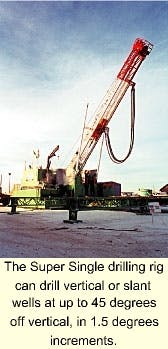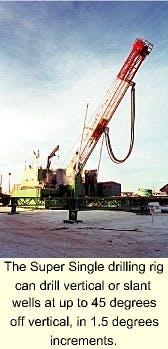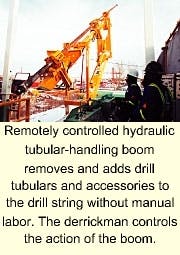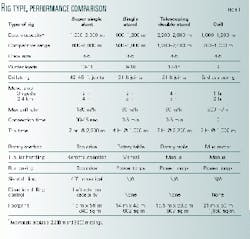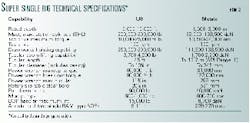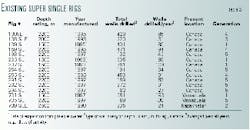Although slant drilling is a technology that has been in use for many years, the latest generation of slant rig designs enables newer rigs to do more than drill at an angle. These designs incorporate the latest drilling technology to accomplish a variety of drilling tasks.
In 1990, Precision Drilling Corp., in conjunction with PanCanadian Petroleum Ltd., designed and constructed a land drilling rig to meet Pan Canadian's specific drilling requirements. The rig, designed for slant, vertical, directional, and horizontal drilling, incorporated safety and control features, along with swift rig up, rig down, and moving capabilities as priorities.
The rig handles casing and drillstring tubulars without exposing employees to the heavy labor normally required on conventional drilling rigs. The new rig also could drill multiple shallow wells from a single pad, generating minimum disturbance to the wellsite environment. This venture initiated a new drilling rig concept now known in the Canadian oil patch as the "super single."
Since then, each new generation of these rigs has incorporated improvements and new design ideas based on a variety of factors:
- Operating experience gained from drilling wells with the earlier-generation slant rigs and with Precision's 200 conventional rigs.
- Changing business and social environments such as the need for minimum site disturbance at well locations.
- Customer feedback and requirements regarding the pad location size, safety, and drilling efficiencies.
- Equipment availability.
- Feedback from field and repair personnel.
- In-house design innovations.
The early generation rigs were marketed as single slant drilling rigs.
"They're a single, but they're certainly capable of going much deeper than a single. I believe it was Marathon [Canada Ltd.] that coined the phrase 'super singles' when the rigs were extended from Range II drillpipe that's 9 m long to Range III drill pipe that's 13 m long," said John Miller, drilling superintendent for PanCanadian, who carried out most of the performance comparisons between rig types. PanCanadian has been using the rigs since they were first developed.
The rig's history, current statistics, and operator demand indicate that they are competitive with conventional cantilever doubles, telescoping doubles, and singles (Table 1). The rigs have drilled wells that vary considerably in type, depth, and other characteristics (Table 2).
Of the drilling rigs currently in Precision's rig fleet, 7% are the slant-drilling rigs. Since 1990, Precision has designed, built, or refurbished 15 such rigs, which have drilled more than 5,000 wells in the last 10 years, some averaging 100 wells/year (Table 3).
New generations
The working experience of the rigs through the years has provided valuable information for each new rig generation.
Recently Precision commissioned two new "Generation 5" slant rigs completed in 2000. Another two, still under construction, will be classed as "Generation 6." They are expected to be field ready within first quarter 2001 (Table 4).
"The rigs have remotely controlled tubular-handling systems, masts that can tilt from vertical to 45 degrees in 1.5 degrees increments, and reversible single or dual-speed top drives," said Precision Drilling engineer Ron Isinger, who has been involved in rig design and operations since 1982.
"One key advantage to starting a well at a sharp incline is the reduction of wellbore build rate from vertical to horizontal-a reduction in dogleg severity-during the drilling of very shallow horizontal wells," he said.
The use of programmable logic controls (PLCs), which had already been a feature of these rigs, has increased in the latest generations. PLCs control the disc brakes and provide an auto-drilling function. In addition, the PLCs simplify the communications systems-such as those for the accumulator system-and improve data acquisition.
Safety, efficiency gains
On these rigs, two operators-the driller and the derrickman-use remote controls to accomplish the handling of all tubulars. The system requires no roustabouts or roughnecks to physically move tubulars from racks to the catwalk or to manipulate them on the rig floor.
Removing personnel from hazardous environments and heavy, repetitive work typically involved in tubular handling has resulted in a significant improvement in rig floor and catwalk safety statistics associated with these rigs.
"It's much safer," Miller said, "than the days of spinning chains and swinging tongs; they were just more things to get people hurt."
The derrickman operates a hydraulic power wrench for tubulars makeup and breakout, and the carrier for positioning it. He also controls a tubular kicker and indexer system that can index tubulars from the catwalk, individually, into the tubular-handling boom, or kick tubulars out of it onto the racks or tables for storage.
Using the automatic controls, he places all tubulars in the hydraulically activated tables and racks. When he moves the desired tubular to the catwalk, the hydraulic tubular-handling boom lifts it to the rig floor. Once the tubular is on the rig floor, the derrickman remotely operates the power wrench for makeup. Similarly, when coming out of the hole, the tubulars are laid down and returned to the racks or tables via remote control, without any manual intervention.
The driller remotely operates air-powered tubular slips for drill tubulars and hydraulic catheads for use with manual tongs when a power wrench is not applicable. He also operates the hydraulically powered, pull-down system for inducing artificial gravity on long-reach, horizontal well sections and a single or dual-speed, reversible top drive with integral traveling block and orientation lock.
The rig has reduced connection times, to 30-45 sec for this slant rig compared with 3-5 min for conventional, telescoping double, or other single slant rigs.
"Using the longer drillpipe is a timesaver going in," said Miller, "You have a third less connections when you're drilling the hole. Over a couple thousand meters of hole-say it was 150 connections-if you have to trip the bit, you have to make the connections going both ways. It certainly adds up."
Fewer and faster connections make trip times comparable to that of a double-stand rig at 2,200 m well depth. During drilling of more-conventional vertical wells, the operational efficiency compares with conventional single or double-stand rigs.
"The one thing that really saves time on these rigs," said Miller, "is they lay all the drill pipe down when they come out of the hole. With the hydraulic arm, the pipe is all laid down every trip.
"On a conventional rig, when you come out of the hole, you stand all the drill pipe in doubles in the derrick. And then, if the well is deemed to be a good well, you then have to run all the pipe back into the ground, circulate and condition the hole, pull all the pipe back out, lay it down and then pick your casing up and start running it in the hole. This could be anywhere from 5 to 10 hr of rig time.
"With the top-drive rig, with the pipe already laying on the ground, after you've got your logs, if it's a good well you just pick up casing. You don't have to run the pipe all back into the well to lay it down; it's already down.
"Now, when you have to trip the bit, the super single has to break connection every 13 m, but the double would only have to break connection every 18 m, so he would gain a little on that trip. But then, when you get the TD of the well, the double [rig] stands all the pipe in the derrick and has to do that whole run-in-the-hole, circulate, pull out and lay everything down, whereas the super single has already got that done."
Operators have achieved drilling rates of 185 m/hr-with mechanical downtime held to less than 0.5%-and trip speeds of 300 m/hr.
The drilling system is designed around the use of:
- 45-ft lengths of drill pipe (API Range III) with diameters up to 51/2 in.
- Heavy-weight drill pipe in conventional lengths (API Range II).
- Drill collars in conventional lengths with diameters up to 8 in.
- Casing in conventional lengths (API Range III) with diameters up to 133/8 in. (Table 2).
The fluid-containment system, designed to accommodate drilling at any angle, reduces drilling fluid loss in the cellar area below the rig floor.
"It [the system] is bigger-probably 100 bbl bigger-than a conventional single, but it's similar to what a double would be," said Miller.
The driller uses a remotely controlled hydraulic system to set the blowout preventer (BOP) at the correct angle for the wellhead, and the fluid containment system keeps to a minimum any fluid loss due to the angle of the BOP while maximizing fluid head for fluid transfer to the shale shakers.
"These features are important especially in environmentally sensitive areas," said Isinger.
Programmable control
The latest generation of these rigs incorporates PLC systems to achieve more efficient, safe, and precise equipment control.
During a drilling operation, the driller has the option of selecting a value for the autodrilling function-either weight on bit (WOB), rate of penetration (ROP), or differential pressure. The drilling system will automatically make adjustments to maintain the desired parameter.
By presetting safety limits on other operating parameters, the control system is programmed to sound alerts and keep the drilling system operating within safe limits while the driller analyzes any deviations and takes corrective action.
"The autodrilling mode allows the system to make fine adjustments without manual intervention, similar to the manner in which modern aircraft fly 'by wire,'" Isinger said.
The increased use of PLCs also makes possible operations such as the crown and rig floor protection systems. Using sensors on the drawworks, the PLCs automatically monitor the position of the traveling blocks and prevent damage to the crown and rig floor.
"The rig's "crown saver"* setting automatically decelerates the traveling block as it approaches the crown block," Isinger said, "applying the disc brakes as the traveling block approaches a preset stopping point and not allowing the traveling block to go past that point without a manual override."
Similarly, the "rig floor saver" decelerates the traveling block as it approaches the rig floor and prevents movement past a stop point without a manual override.
To govern braking operations under load conditions, the PLCs use the known capabilities of the braking system, the measured load on the drawworks, and the position of the traveling blocks to adjust the distance needed to safely decelerate the blocks, depending on the load. These automatic controls minimize the chance of human error.
Incorporating PLCs into the various rig systems also simplifies parts of the rig infrastructure such as communication harnesses.
"On a conventional rig," Isinger said, "some BOP control systems require a separate control line for each function, resulting in large bundles of control cables. PLCs, on the other hand, reduce the many control lines to one, on which the signals for the various rig systems are multiplexed. The result is a simpler system that can be rigged up and down more quickly."
The engineers designed the controls and system displays to provide a safe, functional working environment for control operators. And the proximity of the control stations enables good communication between the operators.
Data management is simplified. Critical systems measurements are displayed in real time while they are being digitally recorded.
Versatility
In many pad-drilling situations, some wells start out vertical, and others start out slanted at different angles. Having a rig that can handle all the requirements for the differing well types-from vertical to slant to horizontal-improves the overall efficiency of a drilling program.
These variable-position drilling rigs have some features uniquely suited to their diverse roles. Applying enough bit weight can sometimes limit extended-reach and horizontal drilling in shallow reservoirs. Typically the drill string in the vertical portion of a well, less frictional force, generates the WOB.
"But in shallow directional or horizontal wells, there is very little vertical section," Isinger said, "and in the case of a slant well, there is none. In the super single, a hydraulically powered 'pull-down' system allows the driller to add extra axial force to the drill string to help overcome the forces of downhole friction."
The system also plays a key role in the versatility and efficiency of this particular rig. The top drive can rotate in both directions and has been used in counterclockwise rotation to drill short, shallow sections for directional control.
"We had some top drive problems initially, with the earlier models," said Miller, "but they beefed the top drive up on the later editions. But one thing we're doing now that we haven't done before-we're now taking [wells] down to the 2,000 m mark. Whether that will cause more stress on the larger top drives, I don't know.
"The common sense aspect of it says that turning a piece of pipe that is 2,000 m long instead of 1,200 m or 1,500 m long may carry more torque back to the top drive. That may cause some failures later on; we'll have to see. Other operators have gone deeper than I have. I think Amoco [Canada Petroleum Co.] went to 2,200 m."
Isinger said the rig has a depth capacity of 3,000 m.
Improved movement
Designers of the new-generation slant rigs incorporated a modular design to improve the logistics of rig movement. They designed the rigs for quick well-to-well moves in a pad environment and for fast moves from pad-to-pad or for individual wells in a variety of road conditions.
"It is not uncommon in Canada for pads to contain 20 or more closely spaced wells," Isinger said. "A simplified rig-trailer configuration allows the drilling module to move as one unit."
It may take as little as 2 hr to rig down on one well and up on another. One of the slant rigs in Venezuela was modified to move itself with a hydraulic jacking system. The rig, which can move 5 ft longitudinally and 4 in. laterally at the same time, uses a jacking set of support pontoons and literally "walks" from well to well.
"During the springtime thaw in Canada, road conditions can be extremely poor," Isinger said, "so the drilling module was designed for disassembly into reduced weight loads. The modular design allows movement of the rig in as [few] as 10 trailer loads, with minimum disassembly time."
Operation-driven technology
Operators today have technically demanding drilling programs driven by economics. What was thought of as exotic and expensive 10 years ago is now commonplace, even in shallow reservoir development and exploration.
Drilling extended horizontal wells, multilateral wells, and twinned horizontal wells in shallow reservoirs is common when employing the steam-assisted gravity drainage (SAGD) enhanced-recovery method for extracting heavy oil.
In SAGD, two horizontal wells are paired, one above the other, for the entire length of the lateral section. In one shallow SAGD pad program in Alberta, several well pairs are being drilled into a reservoir at a true vertical depth of 180 m with a horizontal displacement of 1,000 m, starting with a 45 degrees inclined surface hole.
"To keep rig movement time to a minimum, the pad layout and equipment deployment was planned so that only the rig's drilling module was moved from well to well," Isinger said.
Another shallow reservoir in Canada, located under a lake, was drained with a shallow extended-reach well. In this program, the operator drilled the well to a measured depth of 3,000 m from a starting angle of 45 degrees and a final interception angle of 55 degrees.
These variable-position slant rigs have also been used in such diverse programs as multilateral horizontal wells and underbalanced horizontal wells.
Outside of Canada, Precision's technology has been applied in Venezuela and Kazakhstan.
*Precision's version of what is generally referred to in the industry as a crown-o-matic.
